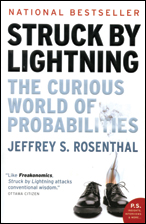 |
Jeffrey S. Rosenthal. Struck By Lightning. The Curious World of Probabilities. HarperCollins Publisher, Ltd., 2005.
This book has nothing whatsoever to do with art – but it is entirely work-related, as I’m reading it for my research into theories of chance and probability, the general theme of the 2011 Biennale Montreal that I’m co-curating. It seems that the author is some kind of brainiac who received his PhD in mathematics from Harvard at the age of 24! Fortunately, Rosenthal delivers his intricate theories in very accessible language and a likable tone, and often with humour – or at least as humorous as one can possibly be writing about mathematical probability. Although I’ve just started the book, I’m looking forward to reading chapters with intriguing titles like, The Case of the Collapsing Casino, Randomness to the Rescue: When Uncertainty is Your Friend and Spam, Spam, Probability and Spam. It all sounds great, but I’m not entirely sure how much probability theory I can take. At this point I’m not betting on my chances of finishing the book. But by the end of it, I’m fully expecting to derive inspiration for the Biennale.
|